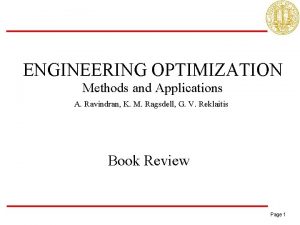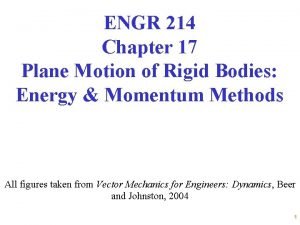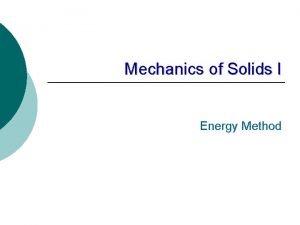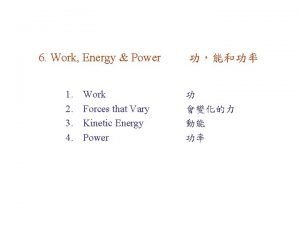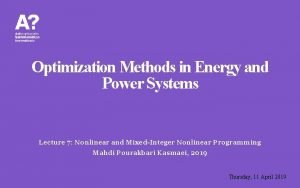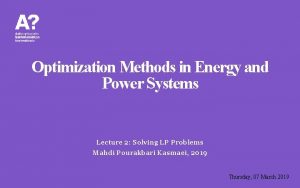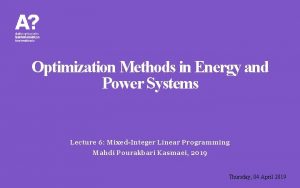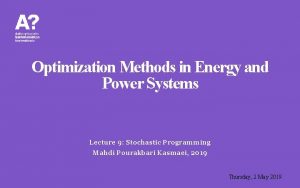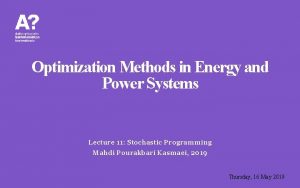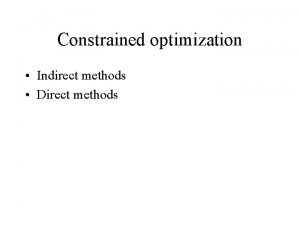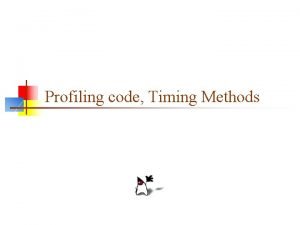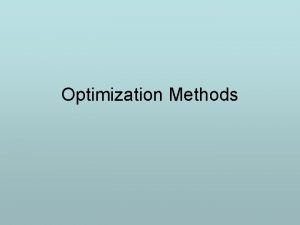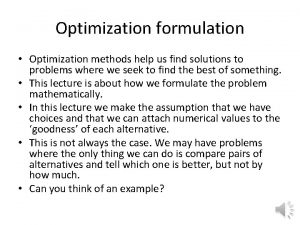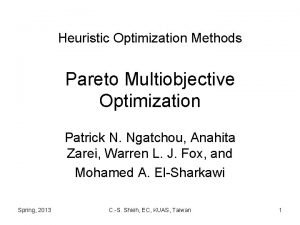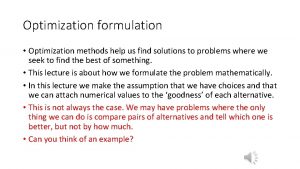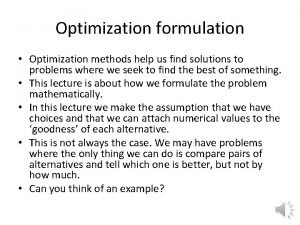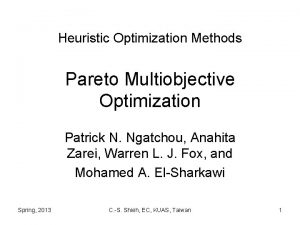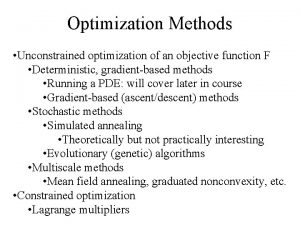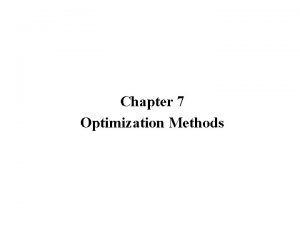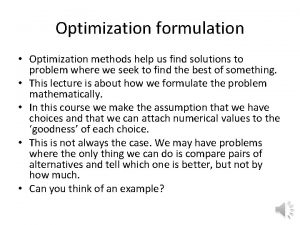Optimization Methods in Energy and Power Systems Lecture








































- Slides: 40

Optimization Methods in Energy and Power Systems Lecture 4: Sensitivity Analysis & LP Duality Mahdi Pourakbari Kasmaei, 2019 Thursday, 21 March 2019

LP Problems (Sensitivity Analysis & LP Duality) ü Marginal Values (Shadow Prices and Reduced Costs) and Sensitivity Ranges are used in conducting Sensitivity Analysis. ü Simplex method (used in solvers) provide extra information than the optimal solution. It provides Marginal Values. 2

LP Problems (Sensitivity Analysis) ü Marginal values give information on the variability of the Optimal Solution due to changes in the Input Data. ü Shadow Prices are associated with the right-hand side (RHS) of the constraints. ü Reduced Costs are associated with the basic variables and their corresponding bounds. 3

LP Problems (Sensitivity Analysis) Only use the Concepts of Marginal Values for LP Problems. 4

LP Problems (Shadow Prices) ü One unit change in the RHS of the constraints results in a change in the Objective Function. • Positive Shadow Price means that the objective function will increase by increasing the RHS by one unit. • Negative Shadow Price means the objective function will decrease by increasing the RHS by one unit. 5

LP Problems (Shadow Prices) ü If there exist non-binding constraints in the LP problem, changing the RHS results in no change in the Objective Function. The Shadow Price is Zero. • Binding Constraints!? ? Those constraint that restrict the optimal solution; Intersected Lines. • Non-Binding Constraints!? ? Those constraint that are not affecting the Optimal Solution. 6

LP Problems (Shadow Prices) Non-binding Constraint 7

LP Problems (Shadow Prices) Binding or Non-Binding Constraints Could become Non-Binding or Binding ones as data Change. 8

LP Problems (Shadow Prices) ü How we can take the advantage of Shadow Prices? ! • To objective function is improved by weakening (relaxing) the binding constraint, i. e. , enlarging the feasible region. • Improving for Minimization and Maximization problems mean decreases and increases the RHS, respectively. 9

LP Problems (Shadow Prices) 10

LP Problems (Shadow Prices) • As discussed, any Equality Constraint can be transformed into two inequality constraints; in this case, at most one of them will have a nonzero Shadow Price. 11

Solving LP Problems (Shadow Prices) ü Sign of the Shadow Price can be used to infer the sign of the binding constraint: • Considering a Minimization Problem, if the Shadow Price of a binding Equality Constraint is Negative, it means that the Objective Function will decrease (improve) if the RHS increases. 12

LP Problems (Shadow Prices) Example 4. 1 VARIABLES Z; POSITIVE VARIABLES x 1, x 2; EQUATIONS Eq. Obj, Eq 1, Eq 2, Eq 3, Eq 4, Eq 5; Eq. Obj. . z =e= 2*x 1 + x 2; Eq 1. . x 1 + x 2 =g= 62; Eq 2. . (2/3)*x 1 + x 2 =l= 68; Eq 3. . 2*x 1 + 0. 3*x 2 =g= 50; Eq 4. . x 1 =l= 50; Eq 5. . x 2 =l= 40; MODEL LP_ED /ALL/; Solve LP_ED using LP Minimizing Z; LOWER ---- VAR Z -INF ---- VAR x 1. ---- VAR x 2. LOWER ---- EQU Eq 1 ---- EQU Eq 2 ---- EQU Eq 3 ---- EQU Eq 4 ---- EQU Eq 5 LEVEL 62. 000 -INF 54. 667 50. 000 56. 000 -INF 22. 000 -INF 40. 000 LEVEL UPPER 84. 000 +INF 22. 000 +INF 40. 000 +INF MARGINAL. . . UPPER MARGINAL +INF 68. 000 +INF 50. 000 40. 000 2. 000 0. 000 -1. 000 13

LP Problems (Shadow Prices) Example 4. 1 LOWER ---- EQU Eq 1 ---- EQU Eq 2 ---- EQU Eq 3 ---- EQU Eq 4 ---- EQU Eq 5 LEVEL 62. 000 -INF 54. 667 50. 000 56. 000 -INF 22. 000 -INF 40. 000 UPPER MARGINAL +INF 68. 000 +INF 50. 000 40. 000 2. 000 0. 000 -1. 000 Moving up enlarges the Feasible Region Moving up tightens the Feasible Region 14

LP Problems (Shadow Prices) ü Sufficiently Small Changes in the RHS of Nonbinding Constraints has no effect on the Objective Function, while a sufficiently small change in the RHS of Binding Constraints results in a change in the Objective Function. • Big Changes may change the nature of Binding and Non-Binding Constraints. 15

LP Problems (Shadow Prices) Example 4. 2 LOWER ---- EQU Eq 1 ---- EQU Eq 2 ---- EQU Eq 3 ---- EQU Eq 4 ---- EQU Eq 5 ü Let us change the RHSs. LEVEL 62. 000 -INF 54. 667 50. 000 56. 000 -INF 22. 000 -INF 40. 000 UPPER MARGINAL +INF 68. 000 +INF 50. 000 40. 000 2. 000 0. 000 -1. 000 VARIABLES Z; POSITIVE VARIABLES x 1, x 2; EQUATIONS Eq. Obj, Eq 1, Eq 2, Eq 3, Eq 4, Eq 5; Eq. Obj. . z =e= 2*x 1 + x 2; Eq 1. . x 1 + x 2 =g= 63; Eq 2. . (2/3)*x 1 + x 2 =l= 68; 84 + 2 Eq 3. . 2*x 1 + 0. 3*x 2 =g= 50; Eq 4. . x 1 =l= 50; Eq 5. . x 2 =l= 40; MODEL LP_ED /ALL/; Solve LP_ED using LP Minimizing Z; ---- VAR Z ---- VAR x 1 ---- VAR x 2 LOWER -INF. . LEVEL 86. 000 23. 000 40. 000 UPPER MARGINAL +INF. 16

LP Problems (Shadow Prices) Example 4. 3 LOWER ---- EQU Eq 1 ---- EQU Eq 2 ---- EQU Eq 3 ---- EQU Eq 4 ---- EQU Eq 5 ü Let us change the RHSs. LEVEL 62. 000 -INF 54. 667 50. 000 56. 000 -INF 22. 000 -INF 40. 000 UPPER MARGINAL +INF 68. 000 +INF 50. 000 40. 000 2. 000 0. 000 -1. 000 VARIABLES Z; POSITIVE VARIABLES x 1, x 2; EQUATIONS Eq. Obj, Eq 1, Eq 2, Eq 3, Eq 4, Eq 5; Eq. Obj. . z =e= 2*x 1 + x 2; Eq 1. . x 1 + x 2 =g= 62; Eq 2. . (2/3)*x 1 + x 2 =l= 68; 84 - 1 Eq 3. . 2*x 1 + 0. 3*x 2 =g= 50; Eq 4. . x 1 =l= 50; Eq 5. . x 2 =l= 41; MODEL LP_ED /ALL/; Solve LP_ED using LP Minimizing Z; ---- VAR Z ---- VAR x 1 ---- VAR x 2 LOWER -INF. . LEVEL 83. 000 21. 000 41. 000 UPPER MARGINAL +INF. 17

LP Problems (Shadow Prices) Example 4. 4 LOWER ---- EQU Eq 1 ---- EQU Eq 2 ---- EQU Eq 3 ---- EQU Eq 4 ---- EQU Eq 5 ü Let us change the RHSs. LEVEL 62. 000 -INF 54. 667 50. 000 56. 000 -INF 22. 000 -INF 40. 000 UPPER MARGINAL +INF 68. 000 +INF 50. 000 40. 000 2. 000 0. 000 -1. 000 VARIABLES Z; POSITIVE VARIABLES x 1, x 2; EQUATIONS Eq. Obj, Eq 1, Eq 2, Eq 3, Eq 4, Eq 5; Eq. Obj. . z =e= 2*x 1 + x 2; Eq 1. . x 1 + x 2 =g= 62; Eq 2. . (2/3)*x 1 + x 2 =l= 68; 84 + 0 Eq 3. . 2*x 1 + 0. 3*x 2 =g= 50; Eq 4. . x 1 =l= 51; Eq 5. . x 2 =l= 40; MODEL LP_ED /ALL/; Solve LP_ED using LP Minimizing Z; ---- VAR Z ---- VAR x 1 ---- VAR x 2 LOWER -INF. . LEVEL 84. 000 22. 000 40. 000 UPPER MARGINAL +INF. 18

LP Problems (Reduced Costs) ü The Marginal Value corresponds to a decision variable is interpreted as its Reduced Cost. ü Reduced Cost stand for the rate of change of the Objective Function for one unit increase in the Bound of a Variable. 19

LP Problems (Reduced Costs) ü If a non-basic variable has a Positive Reduced Cost, the Objective Function will increase with a one unit increase in the binding bound, while if a non-basic variable has a Negative Reduced Cost, the Objective Function will decrease. ü The Reduced Cost of a basic variable is Zero if its bounds are nonbinding and therefore do not constrain the optimal solution. 20

LP Problems (Reduced Costs) ü The Reduced Cost of a variable is non-zero if the variable is at its bound. How to define bounds in GAMS? ? ? • . LO is used to define the lower bound (x 1. lo = c 1) • . UP is used to define the upper bound (x 2. up = c 2) 21

LP Problems (Shadow Prices) Example 4. 5 ü Let us change the RHSs. VARIABLES Z; POSITIVE VARIABLES x 1, x 2; EQUATIONS Eq. Obj, Eq 1, Eq 2, Eq 3; Eq. Obj. . z =e= 2*x 1 + x 2; Eq 1. . x 1 + x 2 =g= 62; Eq 2. . (2/3)*x 1 + x 2 =l= 68; Eq 3. . 2*x 1 + 0. 3*x 2 =g= 50; x 1. up = 50; X 2. up = 40; MODEL LP_ED /ALL/; Solve LP_ED using LP Minimizing Z; ---- VAR Z ---- VAR x 1 ---- VAR x 2 LOWER -INF. . LEVEL 84. 000 22. 000 40. 000 UPPER +INF 50 40 MARGINAL. . -1. 00 22

LP Problems (Shadow Prices) Example 4. 6 ü Let us change the RHSs. ---- VAR Z ---- VAR x 1 ---- VAR x 2 LOWER -INF. . LEVEL 84. 000 22. 000 40. 000 UPPER +INF 50 40 MARGINAL. . -1. 00 VARIABLES Z; POSITIVE VARIABLES x 1, x 2; EQUATIONS Eq. Obj, Eq 1, Eq 2, Eq 3; Eq. Obj. . z =e= 2*x 1 + x 2; Eq 1. . x 1 + x 2 =g= 62; Eq 2. . (2/3)*x 1 + x 2 =l= 68; 84 - 1 Eq 3. . 2*x 1 + 0. 3*x 2 =g= 50; x 1. up = 50; X 2. up = 41; MODEL LP_ED /ALL/; Solve LP_ED using LP Minimizing Z; ---- VAR Z ---- VAR x 1 ---- VAR x 2 LOWER -INF. . LEVEL 83. 000 22. 000 40. 000 UPPER +INF 50 40 MARGINAL. . -1. 00 23

LP Problems (Reduced Costs) ü In Minimization Problem it is favorable to have a variable with Negative Reduced Cost. ü In Maximization Problem, it is favorable to have a variable with Positive Reduced Cost. 24

LP Problems (Sensitivity Analysis) Analysis based on Marginal Values are only Valid for Small Changes. 25

LP Problems (Sensitivity Ranges) ü Sensitivity Ranges Function Value. with constant Objective • Ranges of Decision Variables under this condition depends on the Objective Function. • It can be a unique Optimal Point, or it can be a range of variables corresponding to the Optimal Solution. 26

LP Problems (Sensitivity Ranges) ü For the red Objective Function, unique points exist, however for the green Objective Contour, the ranges of variables are as follows: 27

LP Problems (Sensitivity Ranges) ü Sensitivity ranges with Constant Basis. • Ranges of the Objective Function is determined by changing the slope of Objective Function until the Optimal Solution Changes (It converges to another Extreme Point) 28

LP Problems (Sensitivity Ranges) ü The ranges of Objective Function. 29

LP Problems Duality 30

LP Problems (Duality in Canonical Form) Primal: : Dual Variable Primal Variable 31

LP Problems (Duality in Canonical Form) ü Each constraint in Primal is associated with a Variable of Dual, and each Variable of Primal is associated with a Constraint of Dual. ü If Primal has m constraints and n variables, Dual has m variables and n constraints. 32

LP Problems (Duality in Canonical Form) Example 4. 7: Finding the Dual ü Note that: 33

LP Problems (Duality in Standard Form) Primal: : Dual Variable Primal Variable 34

LP Problems (Duality in Standard Form) Example 4. 8: Finding the Dual ü Note: 35

Dual Primal LP Problems (Duality in General Form) 36

LP Problems (Duality in General Form) ü How to obtain the Dual of a Problem in General Form? • Step 1: Transform the Problem in Canonical Form of a Minimization Problem. • Step 2: Obtain the Dual of the Transformed Problem in Step 1. 37

LP Problems (Duality in General Form) Variabes Constraints Variabes ü The following relations are inferred from the Transformation and Finding the Dual (Previous Slide). (Min Problem) (Max Problem) 38

LP Problems (Duality in General Form) Example 4. 9: Finding the Dual 39

Thanks! 40
 Engineering optimization methods and applications
Engineering optimization methods and applications 01:640:244 lecture notes - lecture 15: plat, idah, farad
01:640:244 lecture notes - lecture 15: plat, idah, farad Ac power formula
Ac power formula Slide todoc.com
Slide todoc.com Energy energy transfer and general energy analysis
Energy energy transfer and general energy analysis Energy energy transfer and general energy analysis
Energy energy transfer and general energy analysis Energy power systems
Energy power systems Power system dynamics and stability lecture notes
Power system dynamics and stability lecture notes Power system dynamics and stability lecture notes
Power system dynamics and stability lecture notes A-wax pattern recognition
A-wax pattern recognition Utilities and energy lectures
Utilities and energy lectures System integration plan
System integration plan The engineering design of systems: models and methods
The engineering design of systems: models and methods Advanced operating system notes
Advanced operating system notes Articulators
Articulators Lecture sound systems
Lecture sound systems Power system analysis lecture notes
Power system analysis lecture notes Power semiconductor devices lecture notes
Power semiconductor devices lecture notes Switch mode power supply lecture notes
Switch mode power supply lecture notes Slide
Slide Agile methods for embedded systems development
Agile methods for embedded systems development Direct methods for sparse matrices
Direct methods for sparse matrices Systems engineering verification methods
Systems engineering verification methods Decision support systems and intelligent systems
Decision support systems and intelligent systems Ldhtest
Ldhtest Energy method in structural analysis
Energy method in structural analysis Energy methods in solid mechanics
Energy methods in solid mechanics Solar power satellites and microwave power transmission
Solar power satellites and microwave power transmission Actual power
Actual power The dispersive power of a grating
The dispersive power of a grating Unit 2 energy materials systems and devices
Unit 2 energy materials systems and devices Difference between aerobic and anaerobic energy systems
Difference between aerobic and anaerobic energy systems Unit 2 energy, materials, systems and devices answers
Unit 2 energy, materials, systems and devices answers Grade 7 term 3 natural science test
Grade 7 term 3 natural science test Work, power and energy activities
Work, power and energy activities Power definition physics
Power definition physics How are energy work and power related
How are energy work and power related Work power energy and machines
Work power energy and machines F d cos theta
F d cos theta Work power and energy
Work power and energy Jenis usaha apa
Jenis usaha apa
